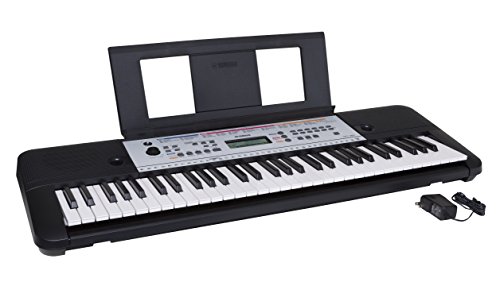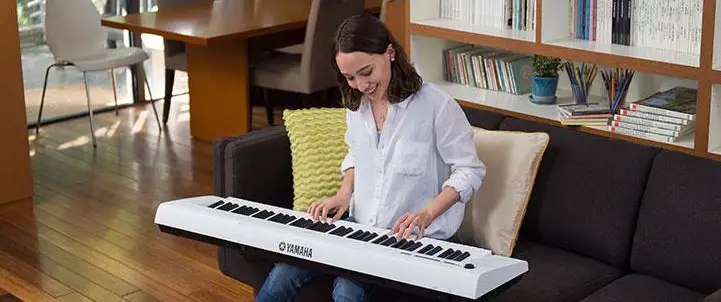When it comes to digital pianos, two brand names stand out more than any others: Casio and Yamaha.
Maybe you’ve already been considering both of these brands because they’re so well-known, but you haven’t made your decision because you still need more information?
Well you’re in luck! In this comprehensive guide we cover Casio vs Yamaha digital pianos and give you the information you need in order to make the best decision, including:
- Features of both brands
- Reasons for and against buying either brand
- Best digital pianos from both brands
- And much more!
Table of Contents
- Which Brand is Better?
- Brand Reputation
- Value for Your Money
- Range of Products
- Skill Level
- Home or Stage/Studio Use?
- Features to Look For
- Other Considerations
- Yamaha vs. Casio Digital Piano
- Final Verdict
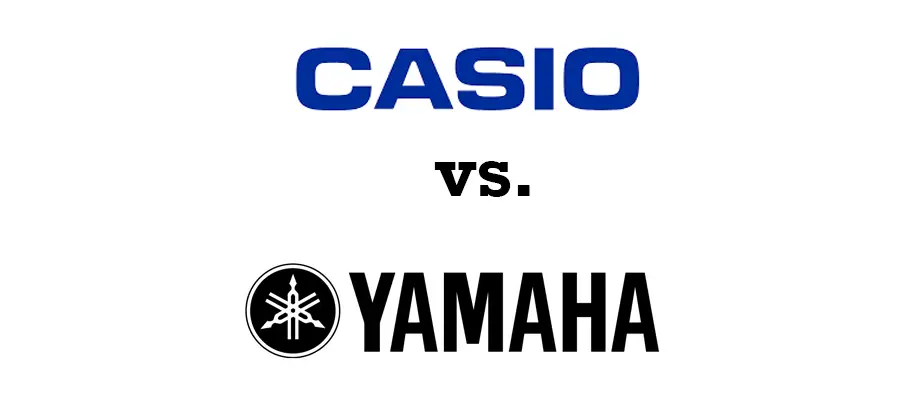
Which Brand is Better?

The first name you might gravitate toward is Yamaha, because it has such a long and rich history of creating quality musical instruments. In fact, you may be inclined to steer clear of Casio products, because many people think of them as being low-end.
But you might just be surprised at the quality of many Casio keyboards and digital pianos. Yes, they do have some inexpensive models that definitely would not be great for professional use, but they also have some high-end models that can directly compete with some of the best that Yamaha has to offer.

There was a time when professionals wouldn’t even consider a Casio digital piano, but this attitude is definitely beginning to change as Casio releases more and more high-quality digital pianos and other digital instruments.
More professionals still tend to prefer Yamaha keyboards, but this is a trend that is starting to move in the Casio direction. Casio has been making several upgrades, and their latest products are getting some pretty great reviews, even from professional piano players.
Brand Reputation

Are you someone who care a lot about brand names? Most of us think that because a brand name is well-known and trusted that it just has to be better than any other brand out there. But, is this really the case?
Don’t let a brand name be your deciding factor because you just may be missing out on a quality instrument. Obviously, the better-known brand is going to have a pretty great selection. But, even though Casio has not been around as long as Yamaha, it doesn’t mean that this brand doesn’t have a great reputation itself. In fact, both brands are favorites of many when it comes to digital pianos.
Both brands are very well established, and well-known for producing quality instruments. Yes, Casio has only been around since 1980, but they have come a very long way in such a short period of time.
That being said, many people are still going to think of Yamaha first when it comes to digital pianos, simply because they have been around for more than 100 years. When you come right down to it, Yamaha is the more reputable brand of the two.
Value for Your Money

We are living in tough economic times, and no one wants to buy something that isn’t going to give them value for their money, including a digital piano. Which brand is going to give you the most for your dollar?
Well, as popular as Yamaha is, they can’t compete with the low prices offered by Casio. Any of the Casio digital pianos are going to have loads of great features that are similar to many Yamaha models, but in most cases, the Casio models are going to cost a lot less than anything from Yamaha.
In fact, you will likely pay more for a Yamaha digital piano, just because it has the Yamaha name. Just keep in mind that more expensive doesn’t always necessarily mean that you are getting a better product.
Range of Products
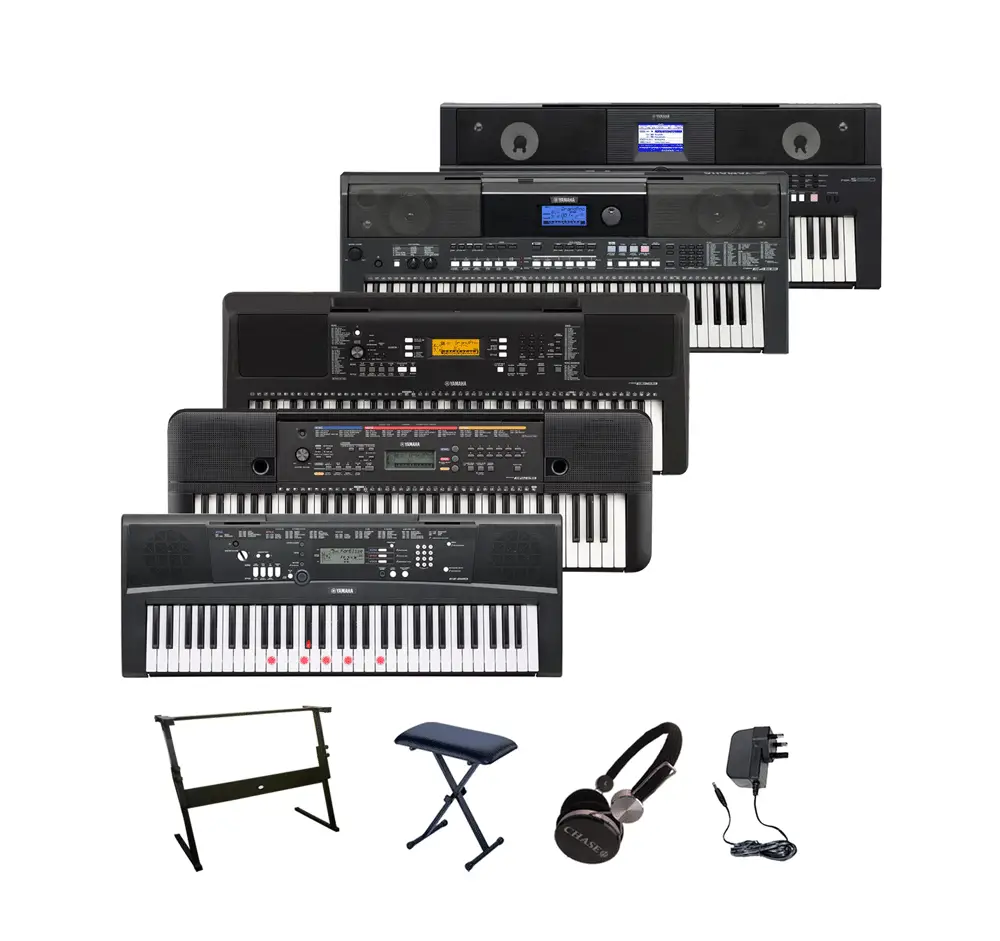
Another thing that you should consider is the range of products from both brands. This is likely where you are going to find that Yamaha gets the higher score, because they do have many more high-end products than Casio.
In addition to digital pianos, Yamaha produces a whole range of other instruments, workstations, and recording/studio gear. There are a few Casio digital pianos in this same category, but Casio just doesn’t have the range that you will find with Yamaha.
But, this doesn’t mean that you should discount the range of products from Casio, as they are coming out with more and more models of digital pianos and other instruments all the time.
You might think that Yamaha has the better range of instruments, but then again, you may just find yourself surprised at what Casio has to offer. For instance, the Privia line has some lovely, furniture-style digital pianos, including the PX-850, as well as portable models like the PX-160. They also have a great little stage piano, the PX5S.
Obviously, this doesn’t come close to the variety from Yamaha, but more doesn’t always mean better. Selection is something that you will need to weigh very carefully when it comes to your decision between these two brands.
Skill Level
Another important consideration is the skill level of the person who will be using the digital piano. If this is going to be for a beginner, it is not going to be necessary to go out and spend a lot of money on a professional piano. The features that you really should be looking for in this case will be built-in learning tools, decent sound quality, and some effects.
If the digital piano is going to be for someone who is more advanced, or even a professional, you will want to look for such features as the touch response, advanced digital features, and even recording and playback capabilities for composing.
Home or Stage/Studio Use?
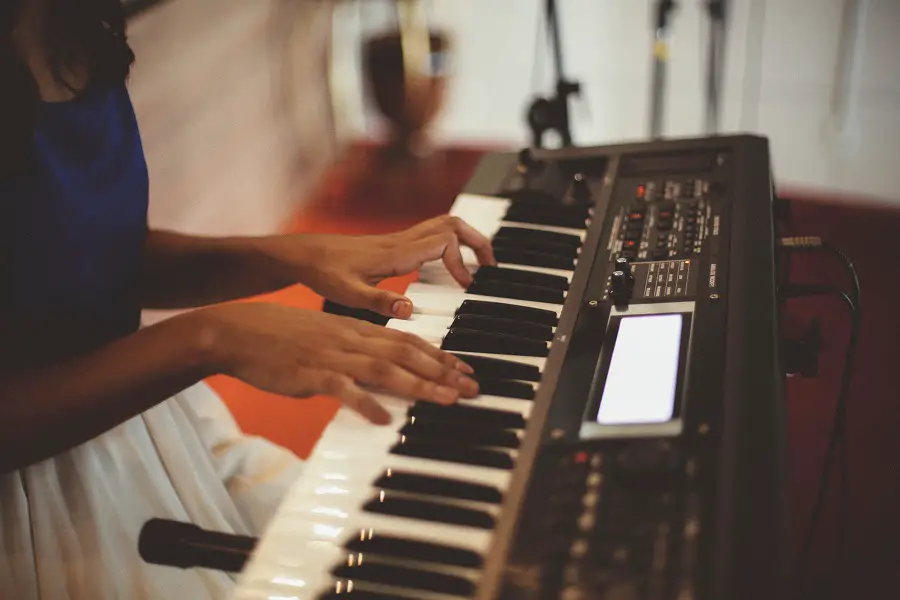
Is your digital piano going to be used at home, or do you plan on using it in a studio and on stage? This is an important question to ask yourself when choosing a digital piano, whether it be from Yamaha, Casio, or another brand. If it is going to be strictly for home use, you may be interested in a console digital piano, which is offered by both Yamaha and Casio. This type of digital piano has built-in speakers, so you don’t need to worry about using an amplifier.
A console piano has a cabinet, which helps it to blend in with your furnishings and décor, and there are many other styles, in a wide range of price, and quality. One from Casio that you may be interested in is the Privia PX360, which uses the Casio AiR (Acoustic and intelligent Resonator) sound engine, a multi-dimensional sound source that help to create the sound of a traditional acoustic grand piano. This digital piano also has 88 full-size keys that are weighted, hammer-action, so it feels like playing a regular piano.
A comparable Yamaha model is the YPG-535. This digital piano also has 88 keys, as well as graded soft-touch action, which is often better for beginners and younger players. Basically, this technology means that the keys will respond differently to different pressure levels. If you hit the keys hard, they are going to play loud, and vice versa.
This keyboard has a built-in amplifier and speakers, and features the Yamaha Education Suite and Performance Assistant Technology that helps students learn faster and easier. It also has a recorder and sequencer, each with six tracks, so you can compose and record.
Now, you may not be as interested in a console piano if you plan on using it in the studio or on stage. Instead, you will probably be looking for something that is more portable. There are great options from both brands when it comes to digital pianos for stage and studio. These tend to have more effects than the home console versions, and they are available at a wide range of prices.
One interesting model from Casio for stage and studio use is the Privia PX-5S Pro. This is a mid-range model that weighs just 25 pounds. This digital piano has a full, scaled hammer-action keyboard, as well as many different voices (instrument sounds), including grand pianos and retro electric pianos.
It offers a 256-note polyphony (more on this later in the article), so you can play even the most difficult and complex arrangements. It also has four-zone MIDI control, with four knobs and six sliders that allow you to control internal sounds and external MIDI gear at the same time.
A comparable Yamaha model is the YPG-235, a 76-key digital grand piano that is also portable. The keys have a Graded Soft Touch (GST) action, and there is a six-track sequencer that allows you to record easily. The LCD panel is backlit, making it easy to see, and there are also panel lights. You can use the USB and Flash ROM to download songs and styles to play around with.
Both the Casio and the Yamaha have comparable features, with the Yamaha model having better in some areas, and Casio in others. Again, this is a tough choice. The best way to really know if a digital piano is right for you is to actually play on it. You might find that the less expensive Casio model is actually your favorite.
Features to Look For
No matter what brand you are ultimately going to choose, it is important to narrow down the features you should be looking for in a decent digital piano. Even if it is just for a beginner, you want to find one that has good sound quality, several voices (more on this later), learning tools, etc.
If you are looking for a professional model, you still want these same features, except maybe the learning tools. Let’s take a look at the most important features to look for on a digital piano.
Volume and Output
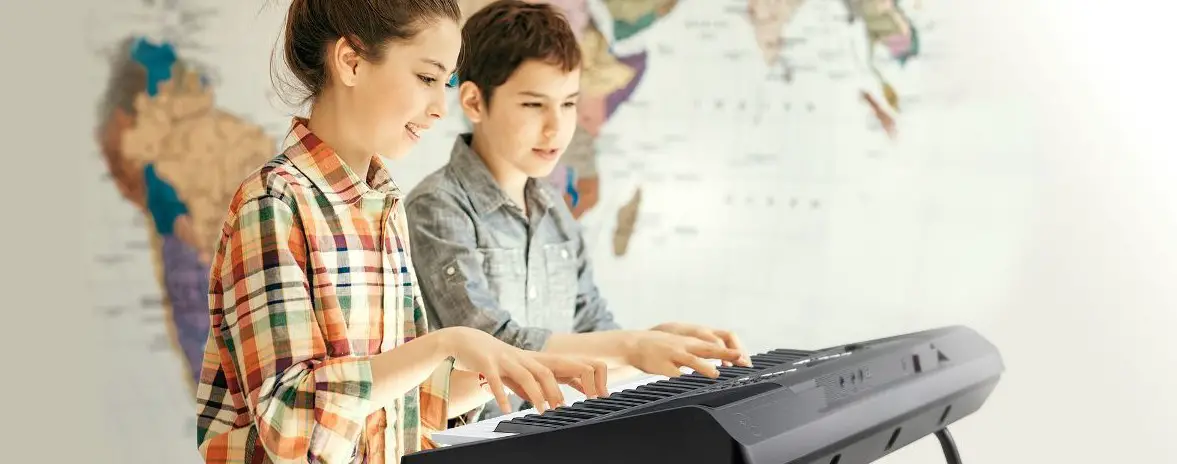
If you aren’t going to be playing through an amplifier, PA, etc., you need to choose a keyboard that has quality sound, with the right amount of volume and output. It will be important to have a keyboard that has built-in speakers, which both Yamaha and Casio models do have.
You may be wondering, why do I need a lot of volume or output if this is going to be a digital piano for a beginner and not for a professional on stage?
Well, even a beginner needs to be able to hear what they are doing. If there isn’t enough volume, it is going to be difficult to tell which notes are being played correctly, and which are being played incorrectly. Not only should there be plenty of volume and output, the sound quality itself needs to be great, whether you are a beginner or a pro.
After all, if you are on stage and your instrument sounds like garbage, people aren’t going to want to pay to see you perform. If you are in the learning stages and your instrument has a lousy sound quality, you are likely not going to want to practice and learn on it.
If you are using an amplifier, you may think that you don’t need to worry about built-in speakers. But, what happens when your amplifier decides it doesn’t want to work, and you need to use the keyboard?
Without built-in speakers, you will simply be out of luck, and won’t be able to play all. This means no practicing for the beginner, and unless you have a backup keyboard, no performing for the professional.
Sound Quality
One of the most important features to look for in a digital piano is the sound quality, which is totally separate from the volume and output. Remember, just because a speaker is loud enough to rattle the windows, it doesn’t necessarily mean that it is going to have a good sound.
While Casio digital pianos do have a decent sound quality, they do not have many models in the $1,000 or more range for semi-professionals and professionals. So, if you are looking for a high-end, expensive keyboard with the best sound quality, Yamaha is probably the best way to go.
On the other hand, if you are looking for something that is less expensive, you may actually find a better sound quality in some of the Casio digital pianos. This is definitely going to be the case if you are looking for a digital piano for a beginning piano player.
Yes, the sound quality is still likely to be better from a Yamaha model, but this isn’t always a key factor to look for in a beginner model. Yes, you want it to sound good, but since it is going to take at least a year or two before you start playing well, is there really any sense in spending a lot more money, just to have the Yamaha name, when you can get a less expensive Casio model that has a good sound quality, and costs a lot less?
Here is something else to consider when it comes to sound quality. If you are planning on using an amplifier, you may find that this is going to improve the sound quality, and the less expensive Casio model may sound absolutely terrific.
When shopping for digital pianos, it is a good idea to try each model you are interested both with and without and amp, just to see if there is any difference in the sound quality.
Key Action and Touch Response
The next consideration is key action and touch response. There is one huge difference between a traditional acoustic piano and a digital model, and that is how the keys feel. True piano keys have some resistance, due to their mechanical components, including the wooden hammers and strings. If you are already an experienced player with an acoustic piano, your best bet is to look for a model that can mimic the action of the type of piano that you are used to playing.
Both Yamaha and Casio offer digital pianos that will give you the same feel as if you were playing on an acoustic piano. Look for a model that has weighted or semi-weighted action, because this is going to have more of a real piano feel. Hammer action will enhance this, because it actually uses hammers as a piano would.
The absolute best, if you want that true piano feel, is to choose a model that has fully weighted keys, or graduated weighting, known as graded hammer action. You will be able to play the low notes heavier, and the high notes lighter with graded hammer action.
Velocity-sensitivity is also important. The absolute best digital pianos will be able to sense minute differences in velocity, and know just how hard you are going to hit each note to give it the correct volume. This is not something you are going to find in a low cost digital piano, whether it is Yamaha or Casio. They will likely have volume level buttons instead, so you have a constant volume.
Other Considerations
You are going to find the best sound quality in a digital piano that has digital sampling. These work by using real samples that are recorded from an acoustic piano, in a professional studio. This is such a difficult task that it is likely that it will play the biggest role in the price of any digital piano.
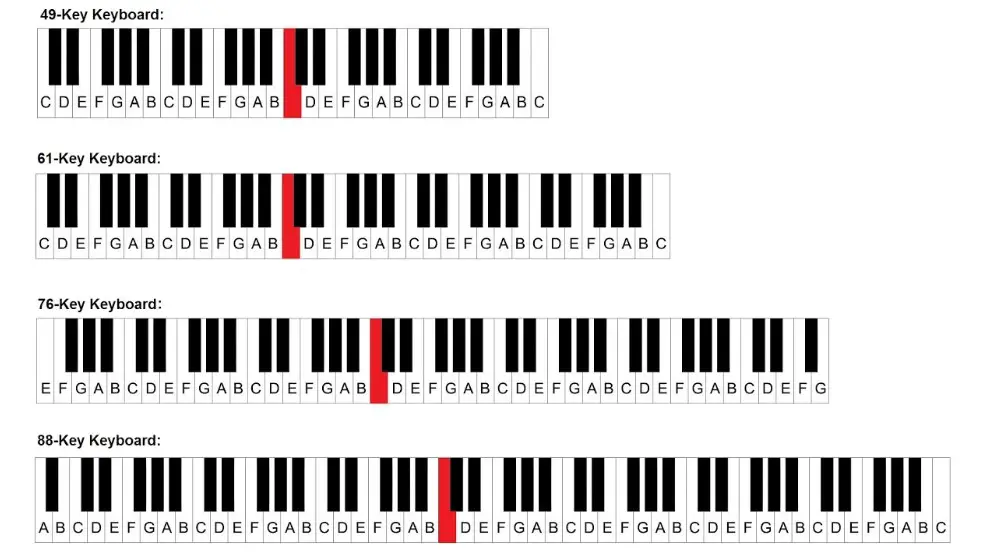
Both Casio and Yamaha offer a variety of digital pianos that have full keyboards, which is what you really should be looking for. Keyboards with fewer than 88 keys are not a total no-no, but if you want to be able to play in the full range, you need all 88 keys.
Beginners can get away with less keys, which is going to save you money in the long run.
Look for a digital piano that offers a variety of voices, or instrument sounds. Both Yamaha and Casio offer numerous voices in all of their digital pianos, including grand piano, organ, synthesizer, flute, accordion, harpsichord, and more. Don’t forget about things like percussion, and effects such as reverb, chorus, and delay.
Here is one feature that is extremely important. Polyphony is the number of voices that can sound at the same time. On cheaper keyboards, such as the low-end Casio models, you will find 32-note polyphone.
Ultimately, you should be looking for at least 64-note, with the best being 264-note polyphony, especially if you are doing accompaniments, using a sustain pedal, or using organ and synthesizer tones.
Both Yamaha and Casio digital pianos are available with advanced learning tools, and have the ability to be able to connect online so you can download other learning software.
Some of the most important learning tools you should look for in a beginner model include built-in metronomes, record and playback functions, accompaniment tracks, and visual aids to help learn chords and scales.
Yamaha vs. Casio Digital Piano
Final Verdict
So, which digital pianos are better, Yamaha or Casio?
This is not something that we can decide for you. Yes, there are more selections from Yamaha, and you know that it is one of the best names in musical instruments, including digital pianos. But, Casio has many models that can easily give Yamaha a run for their money.
When you come right down to it, the final decision is going to be based on several factors, including volume, sound quality, digital effects, and of course, price. Most of all, it is going to come down to your personal preference.
Both Casio and Yamaha have many great models to choose from, and ultimately, your decision will be based on which one offers the best features for your particular playing needs.






